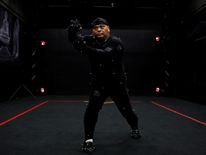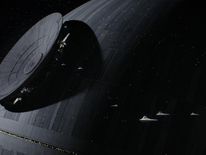*SPOILER ALERT*
Watching it in the cinema before the death of Carrie Fisher, who appears as Princess Leia, felt odd.
Another performance was equally unsettling.
Peter Cushing, who died more than 20 years ago, was digitally resurrected to reprise his role as the grandest moff of all, Governor Tarkin, commander of the Death Star.
The Guardian described it as "a digital indignity", but it is one we probably need to get used to.
Motion capture and CG techniques have advanced to the point where digital avatars of long-gone actors are startlingly realistic.

For Grand Moff Tarkin, actor Guy Henry gave a performance wearing an elaborate motion-capture head rig, his face and body festooned with dots to track movement.
It is a similar set-up to the techniques pioneered by Andy Serkis in films like The Lord of the Rings and King Kong. The difference is combining it with a familiar, human face, in scenes with human actors.
That is when you bump up against the phenomenon of the uncanny valley, a term from robotics and 3D animation.
It is the eerie feeling you get when you see a human replica that is close, but not quite convincing - much more disquieting than seeing a deliberately non-human avatar.
For Princess Leia, a much more fleeting appearance, her face was a purely digital recreation, based on her role in the original film, A New Hope.

Filmmakers have long had to contend with actors dying, but have used different techniques. In 1994, Brandon Lee was accidentally shot dead on the set of The Crow and CG was used to complete his performance. Likewise for Oliver Reed, who died on the set of Gladiator in 1999.
Both those recreations were limited and relied on disguising the digital recreation in shadow.
A turning point was a 2014 advert for chocolate. Galaxy wanted to resurrect Audrey Hepburn for a commercial and turned to London-based visual effects company Framestore to do it.
That was pure, trial-and-error recreation. But Hollywood studios are reportedly keeping scans of current actors at various ages "as an archival thing", according to the Hollywood Reporter.

Now the technology is pretty much there. What about the ethics? The creators of Rogue One received permission from Cushing's estate to revive him for the latest film. Both he and Carrie Fisher were offered special thanks in the credits.
Others aren't so keen: before he died, Robin Williams signed a deed banning the use of his image in films and ads for 25 years after his death.
We'll likely see more actors recreated digitally - especially as we currently live in a nostalgic age, keen on rebooting the classic films of the past.
Luckily, there is a much simpler, more satisfying way of seeing our favourite actors: go back and watch the originals.
No comments:
Post a Comment